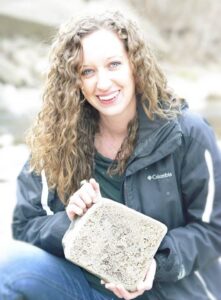Adriane Lam
Binghamton University SUNY
2023-2024 Distinguished Lecturer
She sieves sea shells from the sea floor: Plankton fossils reveal oceanic evolution and dispersal processes
 Planktic foraminifera are single-celled marine protists that create shells (tests) made from calcium carbonate. Their fossil record in the marine realm is superb, and allows for an unprecedented view into the movement of planktic organisms around the world ocean and insight into their evolutionary processes. As such, evolution and extinction events of fossil plankton are used for first-order age control in sedimentary sequences (biostratigraphy). Planktic foraminifera respond to environmental factors, but temperature is the main factor that controls their distribution, dispersal, and diversity through time. As such, this plankton group is incredibly valuable to reconstruct ancient surface ocean currents.
Planktic foraminifera are single-celled marine protists that create shells (tests) made from calcium carbonate. Their fossil record in the marine realm is superb, and allows for an unprecedented view into the movement of planktic organisms around the world ocean and insight into their evolutionary processes. As such, evolution and extinction events of fossil plankton are used for first-order age control in sedimentary sequences (biostratigraphy). Planktic foraminifera respond to environmental factors, but temperature is the main factor that controls their distribution, dispersal, and diversity through time. As such, this plankton group is incredibly valuable to reconstruct ancient surface ocean currents.
The last ~23 million years of Earth’s history, the Neogene and Quaternary periods, features a large increase in planktic foraminiferal diversity, and is the time in which surface ocean circulation came into its modern configuration. This time also includes warming events that are analogous to anthropogenic warming modeled for the coming decades, as well as times of global cooling and ice growth. The Neogene and Quaternary periods are therefore ideal periods of time to study the factors that influence plankton evolution and dispersal across the oceans.
Using data from seventeen previous scientific ocean drilling expeditions, combined with new data developed for Ocean Drilling Program Leg 198 in the northwest Pacific, this study investigates the global movement of planktic foraminiferal through the last 23 million years of Earth’s history. Using global occurrences of the planktic foraminiferal genus Globoconella, the processes that allow for bi-polar distributions (occurrences in the poles but not in the tropics) of species will be investigated, as will how species have dispersed from one ocean basin to another. Such dispersal processes also have implications for use of foraminifera in biostratigraphy. The study finds large diachroneity in species’ first and last occurrences due to oceanic and climatic factors. Such diachroneity should be viewed as a strength, rather than a weakness, of the planktic foraminiferal fossil record.
Dr. Adriane Lam received her B.S. from James Madison University, her M.S. from Ohio University, and her Ph.D. from University of Massachusetts Amherst. Adriane joined Binghamton University as a Postdoctoral Fellow in 2020, and began her career there as an Assistant Professor in the Geology Department in 2023. Adriane works with fossil marine plankton and invertebrates to investigate evolutionary processes of these organisms across major climate perturbations. She also conducts paleoceanographic research, where she reconstructs surface ocean currents across ancient warming events that are analogous to the warming Earth is experiencing today and in the coming decades. Adriane is co-creator and co-President of Time Scavengers, a non-profit organization that provides accessible information about climate change and evolutionary theory to aspects of the general public, and helps support the next generation of Earth stewards. Adriane has participated in International Ocean Discovery Program Expeditions 371 (southwest Pacific Ocean) and 393 (southwest Atlantic Ocean).
LECTURE SCHEDULE
- October 6, 2023 – Hofstra University, Hempstead, NY
- November 2, 2023 – Yale University, New Haven, CT
- February 15, 2024 – Virginia Living Museum, Newport News, VA
- February 27, 2024 – University of West Georgia, Carrollton, GA
- February 29 – March 1, 2024 – University of South Alabama, Mobile, AL
- March 28, 2024 – Syracuse University, Syracuse, NY
- April 8, 2024 – Iowa State University, Ames, IA
- April 11 – 13, 2024 – University of Nebraska Lincoln, Lincoln, NE






